Journeys of Lactic Abstraction
The meanings of milk
Melanie Jackson and Esther Leslie

Milk is primary, but also multiple. It is liquid, solid, powder, emulsion. It is poured, pressed, molded, cast, extruded. It is formless, but can take on any form, even indexing other things that press into it when solidified. It adopts shapes, of vessels or the shapes made of it or in it, when in solid form. Milk is a substance prone to mimesis and abstraction, a duality echoed in the ebullient packaging that places it before us as an industrial staple. For pats of butter or rich creamy milks, there are countless hand-drawn bucolic scenes, realistically formed, that essentialize the gift of nature, of the mother, Mother Nature. Equally, milk is prone to abstraction through technical processing into powdered formulas or constituent parts. This abstraction is reflected in the aseptic geometries of plastic cartons, milk sticks, and Tetra Pak pyramids. The representations on the packaging and the forms of the container either reinforce sentimentalized versions of the chains that lead from cows to humans via commodification, or they bask in the alienation foregrounded by the technologies of production and the industrial triumph of invariant standardization.
Milk is a complicated liquid. It lends itself to reformulation and innovation, just as it reinforces existing social orders as natural. Milk articulates the rules of the nanny and the boss, as well as the technologist and the venture capitalist: it adapts to every kind of flow that the economy demands. Milk participates in a busy activity of human and bovine transformations. In solid, liquid, and powder forms, it is the matter of infinite innovation. Milk is refined, monetized, mechanized, and modernized. It is processed and recombined to extend its functionality.

The McFlurry, Mr. Whippy, Dairy Queen Blizzard, Cheese String, Dreaming Cow, Laughing Cow, Skinny Cow, Happy Cow, Crusha, Marvel—these dairy icons perform health and the abuse of health; an array of high-calorie, high-fat, low-calorie, low-fat, high-sugar, sugar-free, highly processed glimmer, with techno-scientific, multicolor, hedonistic, and eroticized appeal. These are the products of aggressive marketing, of low-margin, highly complex modes of manufacture. Dairy turns airy in ice creams that swell up with nothingness injected, and, as with microfoams in coffee, this airiness—or “overrun,” as it is known in the industry—not only changes the texture, but also seems to stand as a symbol of milk’s overinflated presence and excessive connotative ability in contemporary culture. Transgressive in relation to species origin, and in relation to the edicts of health, yet utterly pervasive, many of these hypernormative products are pitched at young people and children. They collaborate with a plethora of high-energy animated mascots in ecstatic reverie, weaning children from the breast and the bottle through a sugary lure.
Milk’s propensity for animation, for shape-shifting and transformation, teams it commercially with a bestiary of cartoon avatars and a dazzling spectrum of synthetic colors. Milk is frozen into colorful crystals with personality for a teeming frozen-treats market whose products bear ever less tangible relations to milk. In this format, milk adopts any and every shape, that of superheroes or cartoon villains, baroque architectonics or body parts. The cow, used frequently as a metaphor for the passive, dumb, and exploited, is replaced by wily, smart-talking animals and apocryphal consumers of its milk—cats, rabbits, mice—leaving only a vestigial hint of the originating animality. The ontologies of donor species collapse as milk re-forms into consumable biomass.
Though we associate milk with the nursery, a liquid of our childhood, and the childhood of human life, milk is now increasingly a substance for adults. One of the most technologized liquids on the planet, it appears in recombination not only as foodstuff—most visibly in the current proliferation of corporate froth in milky coffee microfoams—but also in fertilizers, deicers, bottle-labeling adhesives, antiwrinkle agents, shampoo, hand cream, floor-leveling compounds, leather finishes, paper coating, concrete, and cement. It can be used to produce ethanol (from whey), and is found in supplements and catalysts, emulsifiers and surfactants. Milk re-enters the human body surreptitiously, as concentrates and isolates. Advertising promotes the incorporation of whey isolates to expand the muscle mass of male bodybuilders, at the same time as it promotes their power to diminish the body mass of female dieters.

Milk extracted or abstracted is a liquid representation of an annihilation of nature over time. In order to produce cows’ milk for humans, the seasonal cycle related to gestation has been extended into the endless time of ever-increasing milk yields. This is the temporality of the market, of production and circulation. Production time is decoupled from the idea of limits and insists that what is profitable be available at all times. Milk flows across the political body, its stream an emblem of progress and the perfectibility of modern times. Situating milk as infinitely available, white, aseptic, and central to the adult Western diet was a quest of modernity. The mass industrialization of milk indicates a mode of industrial metaphysics: an abstraction from its associations with female human and nonhuman animal lactation and its transformation into a de-gendered industrial staple. Luce Irigaray proposed that all Western culture rests on the murder of the mother.[1] In milk and its replication, the efforts to replace or simulate, if not murder, the mother and to negate her capacity to provide milk, are evident. A human-centered philosophy of science assumes that its inventiveness and rationalizations can exceed anything that nature has produced, but, simultaneously, something called nature is essentialized and rendered a source of specific value. What is key is that whatever is devised does not exist in a vacuum, but is drawn into a matrix of valorization, which overdetermines its expressions. According to Elizabeth Grosz, “women’s corporeality is inscribed as a mode of seepage.”[2] Dissociated from messy female bodies, formula milks and processed animal milks extract, separate, and attempt to recombine a problematic fluid into something more streamlined. Bodies become erased in the dynamic of technologically realized reproduction, and modes are sought of imagining milk that obliterate intimacy and bodily exchange. Yet it returns as pornographica and as excessively visceral fantasy. There is an ambivalence attached to milk’s visibility as a source of nutrition and comfort for babies, but also as a seeping spurting image for adult sexual consumption. Lactating breasts are a market niche in the pornographic index: Preggo/Milky.
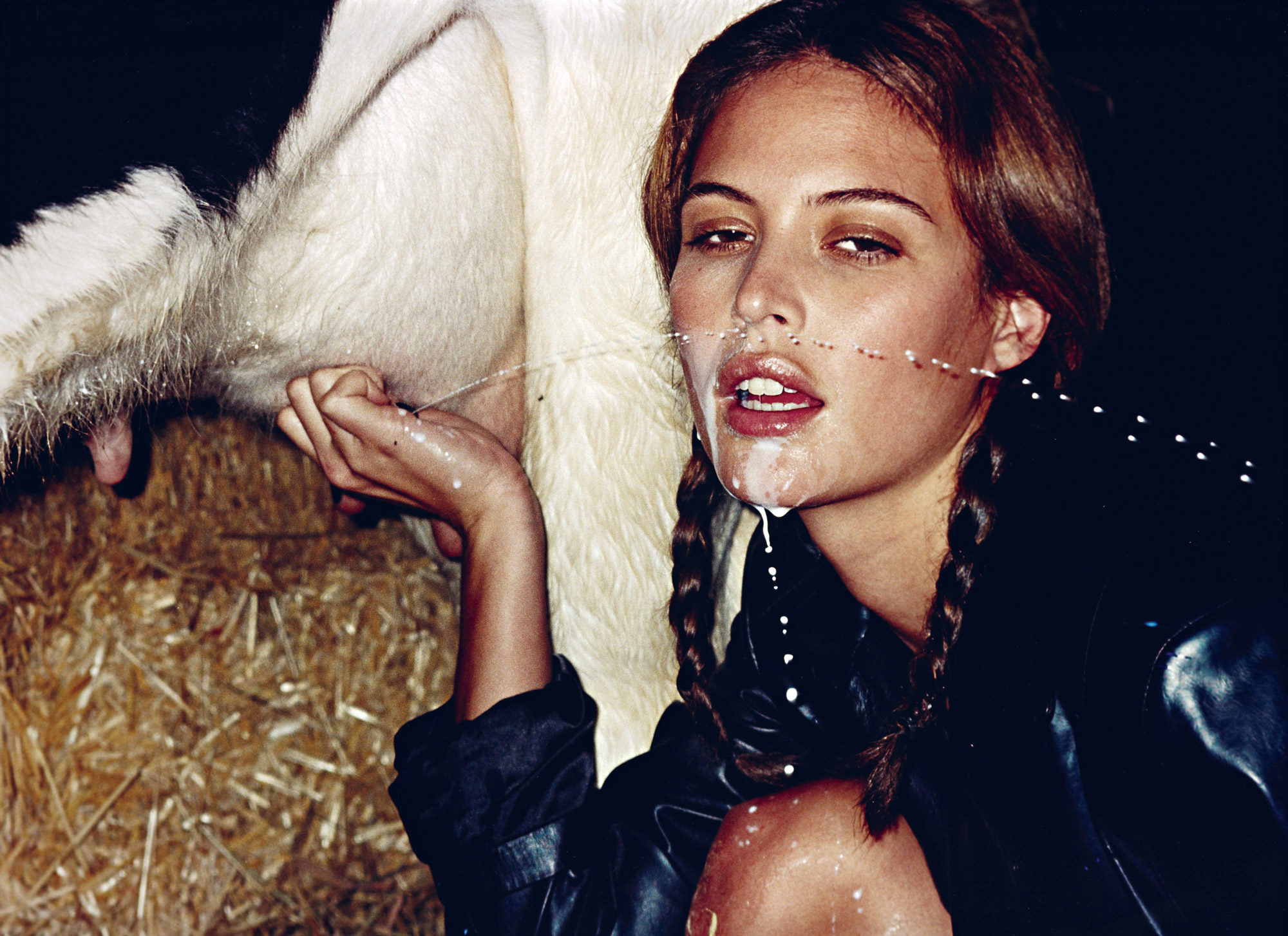

Edgerton’s techniques and technologies later helped detonate and simultaneously photograph the H-bomb. His company, EG&G, designed and activated timing and triggering systems for bomb tests. And he patented a camera, the Rapatronic, with an exposure time as little as two microseconds, in order to photograph the massive expanding flash of the nuclear fireball in the first fractions of a second after discharge. The initial micro-moments of an atomic explosion produce weird irregular bubbles stippled by discrepancies in the density of the bomb’s casing. If the hot force melted the support cables of the nuclear device, along with the surrounding desert sand and the eyes of any close-by onlookers, it also provided an image of melt, of frozen novelties caught at a moment of flux. The parameters of postwar culture might have been set: between hot bomb and frozen dessert, from most deadly to most innocuous. There is the “make anything you like” ice-cream dream of consumerism—emblematized in the boundless varieties of frozen dairy treats, colorful crystals with personality, dustings, aromas, and toppings, proposing a rainbow panoply of infinite possibility and a palette of luscious colors that the painter Willem de Kooning, for one, happily incorporated, straight from the twenty-eight flavors at the ice cream counter of a Howard Johnson’s restaurant.[5] And there is the looming nuclear threat that, if activated, could liquefy it all, could dissolve every upturned eyeball, every pane of glass, making each human a puddle of once-was-ness. This bomb had its own creaminess, suggested in the testimony of journalist William L. Laurence: “The mushroom top was even more alive than the pillar, seething and boiling in a white fury of creamy foam, sizzling upward and then descending earthward, a thousand geysers rolled into one.”[6]

Milk and photographic representation meet again in the digital age. The affinity between the lens and opaque fluid is extended for the commercial screen where the desideratum of digital simulation is the convincing reconstruction of real-world fluid dynamics. Computer-generated imagery (CGI) renders fluid simulations that delight in liquid rapture. Emulation of milk is reputedly the first thing everyone learns to do in CGI.[7] Milk acts again as a kind of primal, or primary, fluid. Spilt milk becomes emblematic of both tragedy and of ecstasy. Captured by photographs or rendered digitally, milk takes on a body. It solidifies into forms that are in a state of suspension before collapse. CGI extends the capacity of milk to adopt any shape. It exploits its presence as liquid and animate, while rendering it as solid and infinitely shape-shifting.
Milk acts like unfired clay in the digital world. The frozen coronet of Edgerton’s milk is donated an illusory capacity for movement and plasticity, combining in its phantasms the liquid and the crystal aspects of contemporary screens. Milk becomes anything, substituting for bullets, charging horses, or billowing dresses, but what it becomes specifically is a substitute for semen, for the ejaculate and its splash. This is something advertising also knew, when it played with milk-cum moustaches on young women’s faces.
Rumored—falsely—to be cast from her own chest, it became a symbol of her suspect lasciviousness. Marie-Antoinette—known as Madame Deficit—had a pleasure dairy based on that of another queen of France, Catherine de Medici, who, childless and unpopular, had the first of her dairies built at Fontainebleu. Marie-Antoinette’s was at Rambouillet, and here she and her bosom friends could play at being milkmaids and consume milk products from a sixty-five-piece Sèvres porcelain service, including porcelain buckets mimicking the wooden counterparts in use in the peasant economy. In the pleasure dairies, women of the elite indulged in a fantasy of nurturing, a quality that France needed to regenerate itself without suffering the agonies of revolution. Madame de Pompadour—a courtesan of Louis XV, if apparently a frigid one—had also set up dairies, as well as sponsoring pastoral festivals. But rather than be associated with the fertile, health-sustaining properties of milk, Madame de Pompadour was rumored to be sickly. Her various ailments were to be ameliorated by milk, and her face was covered by a white mask of makeup made of milk to disguise her blemishes. It was said that she suffered from fleurs blanches, a slang term for venereal disease derived from the white discharge visible in menstrual blood (flueurs). Milk offered an emotional palette against the hyperrationalism that would usher in the guillotine. It is still an emotional agent—for who has not cried over spilt milk? And who has not dreamed of happiness in the land of milk and honey?
The commercial milk vessels of the late twentieth century and beyond resist mimesis, and clay and milk are de-coupled. In Western markets, milk is now available only in one-use, infinitely available, standardized forms. In throwaway cartons, milk signifies both human ascendancy and the rinsed-out, exploited, and spent species of Earth whose yields are optimized but whose bodies are secondary. After years of being promoted as an essential component of the diet, associated with health and well-being, cow’s milk is now a substance of controversy, linked with excess cholesterol, calcium loss, lactose intolerance, and obesity. A liter of milk currently retails for less than a liter of water.
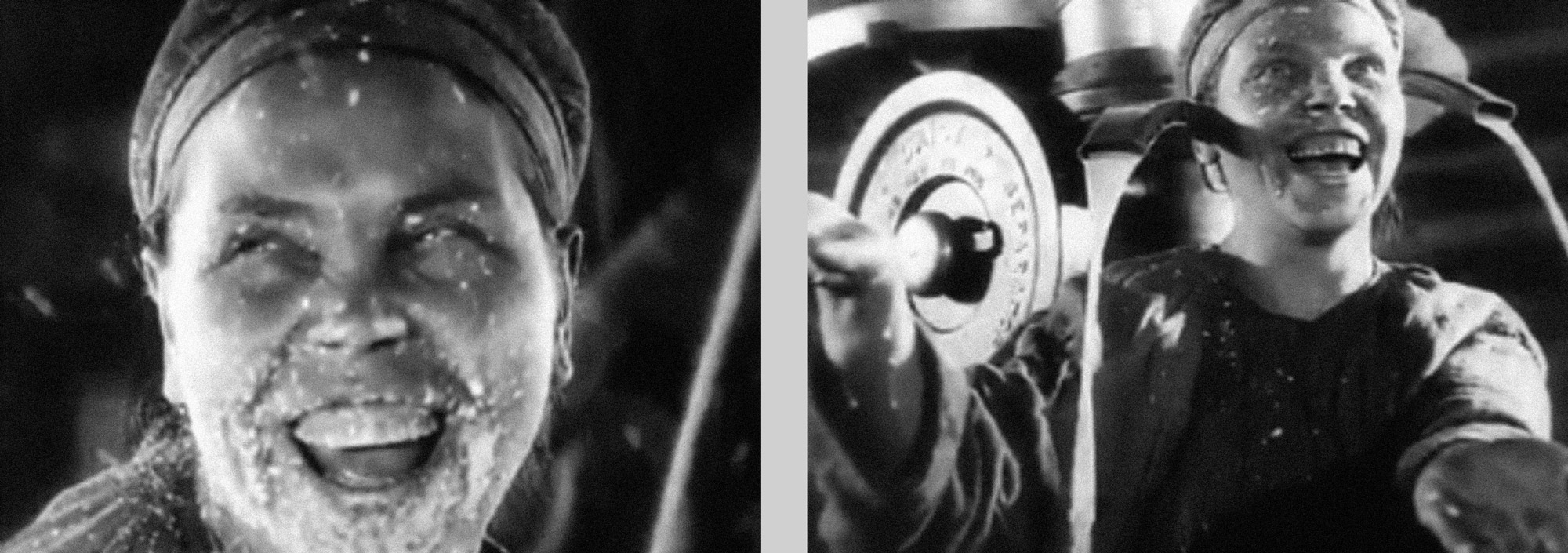
Industrialization produced the decline of the home dairy and the rise of the buttery and amalgamated dairies. In order to move beyond the capture of the cream by the wealthy, Sergei Eisenstein devised his cream-separator sequence in The General Line (1929). The nurturing qualities of milk are transferred to the actions of collectively operated and owned machinery. The cream is drawn off, not by the rich and not by hard graft, but by the machine, for the benefit of the workers. It spurts out ecstatically, another version of milk as cum shot, but conceived in a revolutionary context in which a redistribution of property or properties is imagined to be possible.
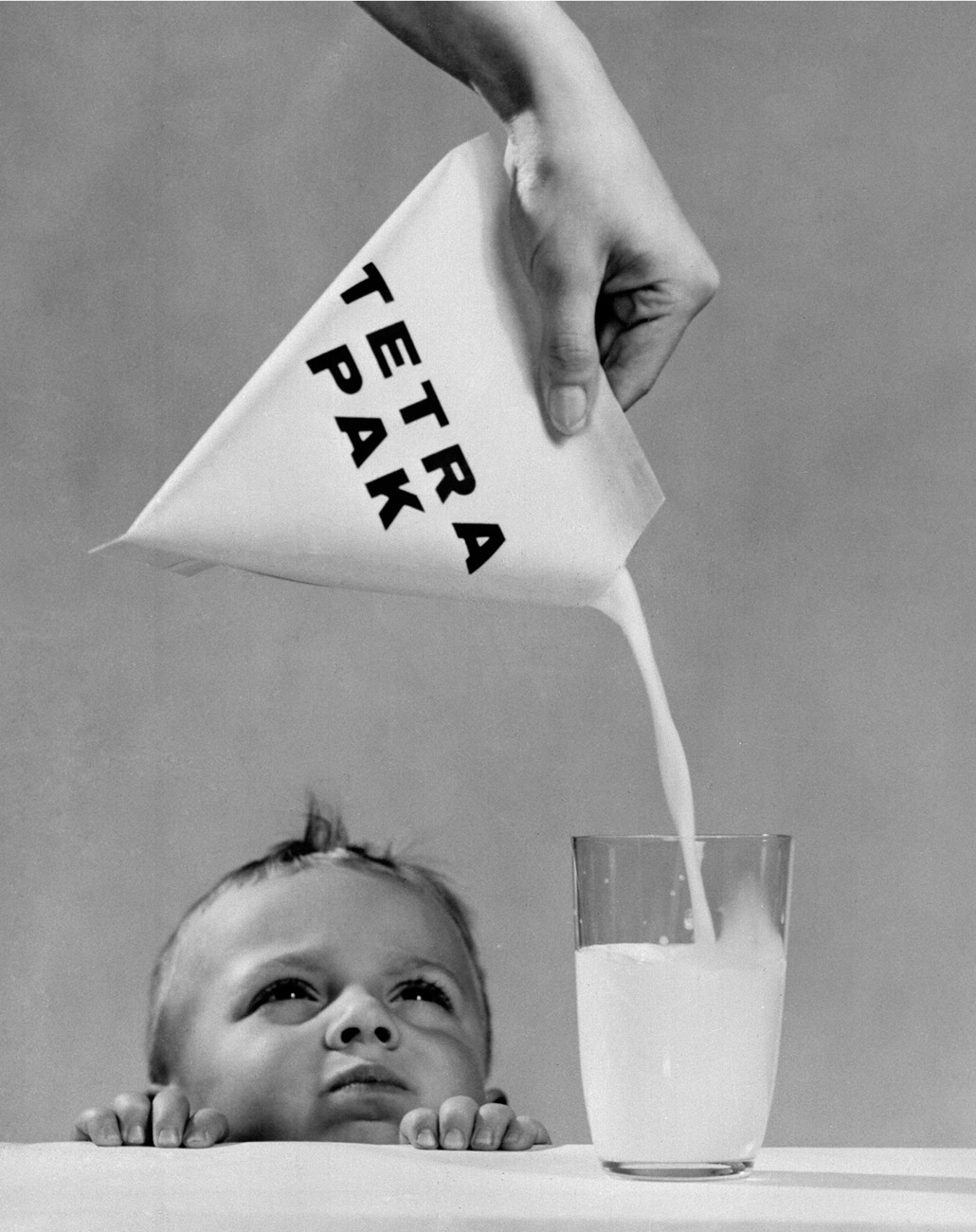
Milk flows into the grid. In this generous grid, milk is conceived as an ideal substance that distributes to all and everyone. The grid is an abstraction that functions in a phase space, illusorily working within an impossible time-space conceived without contradictions. The metaform of the “Milk Grid” is used specifically in relation to India’s national network of milk provision, which was established in the 1970s and which transformed India from a “milk-deficient nation” into the world’s largest milk producer by 1998. (This program, also dubbed the “White Revolution” and “Operation Flood,” was reanimated in 2015, as part of a project to stimulate liquid milk trade across South Asia, in order to push out the imports of milk powders from overseas.) The grid is a powerful image for a network that goes from cow to kitchen and covers an entire territory. It was modeled on the grid-like network of operations originally pioneered by the now-defunct Milk Marketing Board in the United Kingdom, which oversaw an integrated structure, from mechanized milking sheds to tankers to railway distribution. The milk grid can be extended from a motif of milk management in modernity, enmeshed with ideas of “progress,” to the standardization of all its constituent parts—its extended operations going from insemination, gestation, and feeding to extraction, purification, bottling, and processing. Modernity involves the shift from handcrafted processes (technologies of clay to make sieves and vessels) to wood and glass (churners and pats), to metal and mechanical processes in the nineteenth and twentieth century, to robotics and digitized operations of the twenty-first century. Robotic systems can now milk, clean, and feed the milk-making beasts, process and package the produce. In contemporary optimized dairy operations, there is no human contact between cow and human other than when milk enters the mouth. Geometries of milk have emerged to ascertain quality at the level of milk’s micro- and macrostructure. Furthermore, to conceive milk operations as enmeshed in the geometry of the grid is to imagine the precision of the bottling plant, and the clear-cut configurations of cubes or triangles of butter and cheese. The grid produces geometric forms, and the more all is standardized, the sharper the angles, the more platonically ideal the shapes. In testing butter, penetration and compression tests deploy a range of geometries: cone, needle, cylinder, sphere, and plate. Tetra Pak added an additional geometry with its white tetrahedral milk packs and their hexagonal geodesic supermarket stacks. The Tetra Pak is formed from an endless columnal stream of aseptic milk. The innovation that shaped their success was based on the observation that a tube of milk can be poured endlessly and bisected laterally to create this iconic pyramid form, never contacting air, hand, or machine.
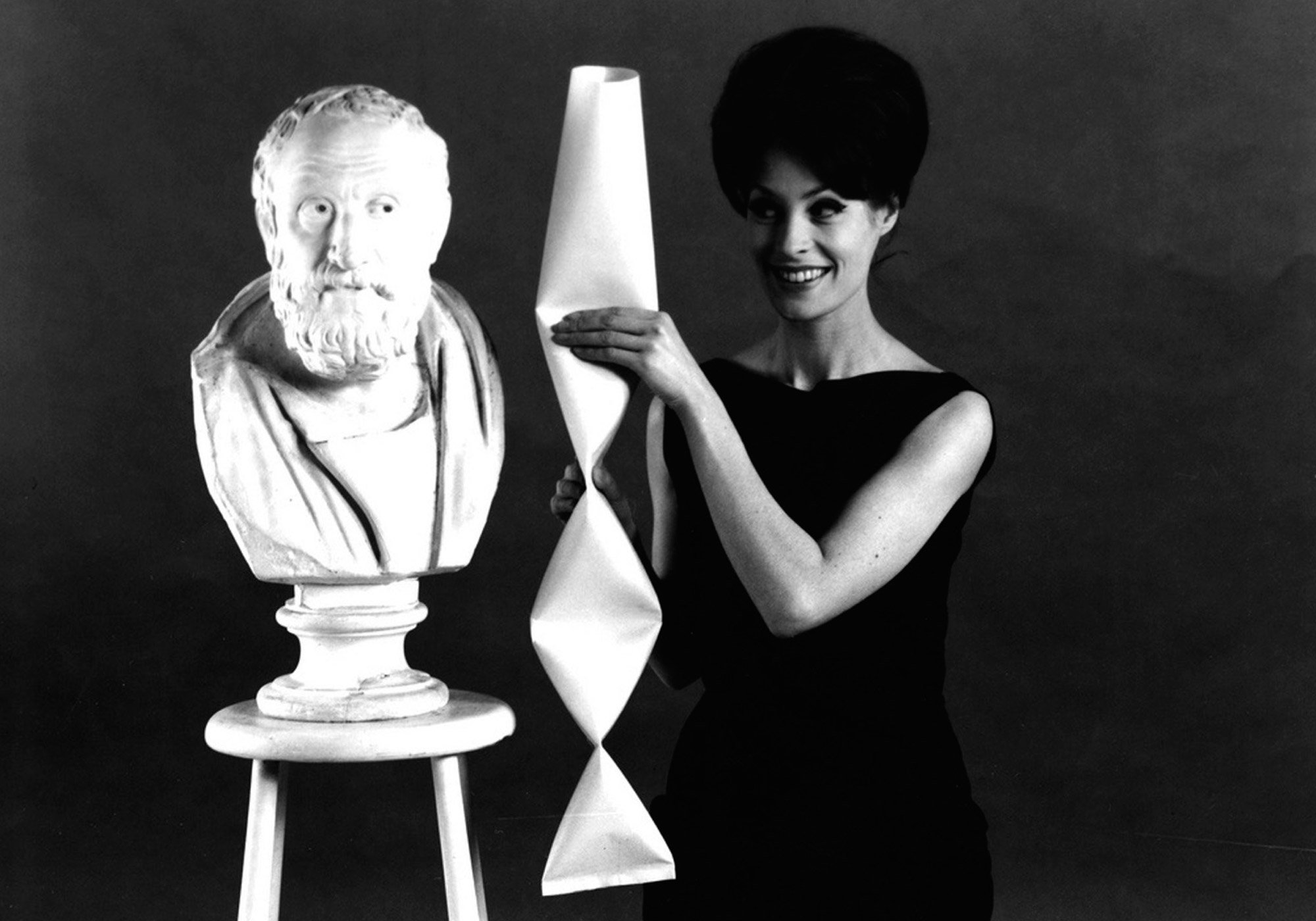
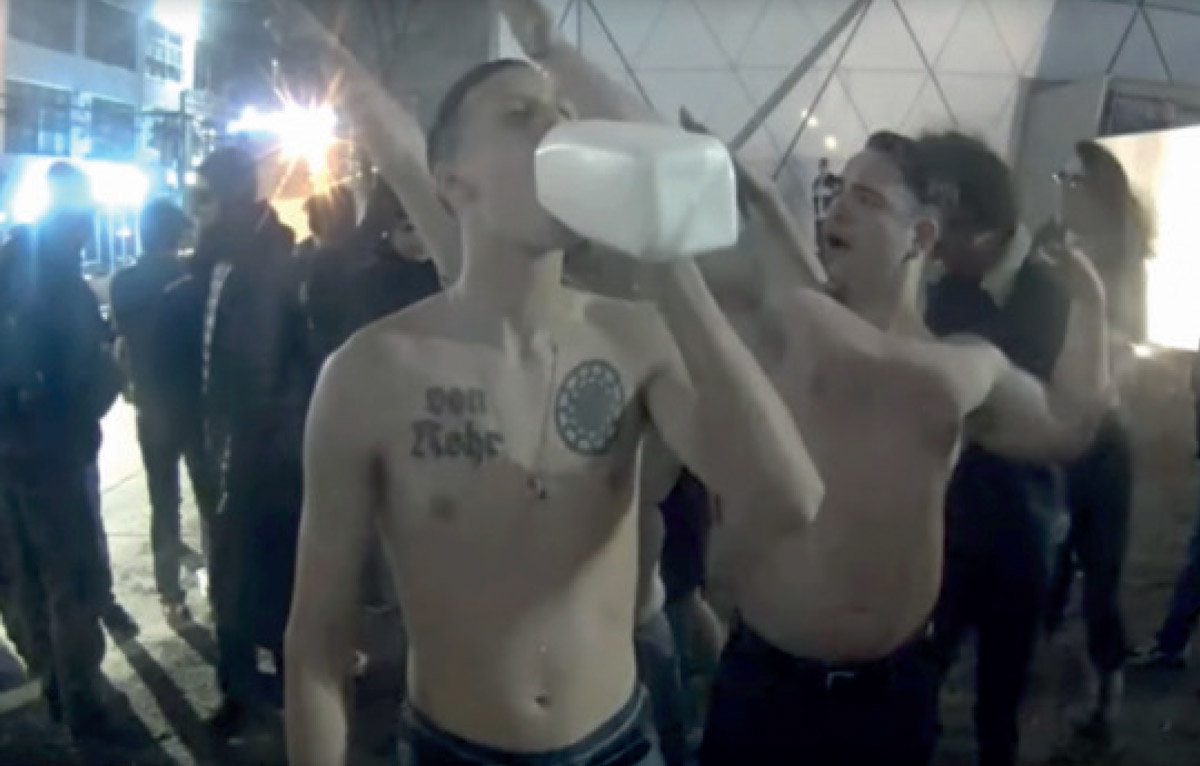
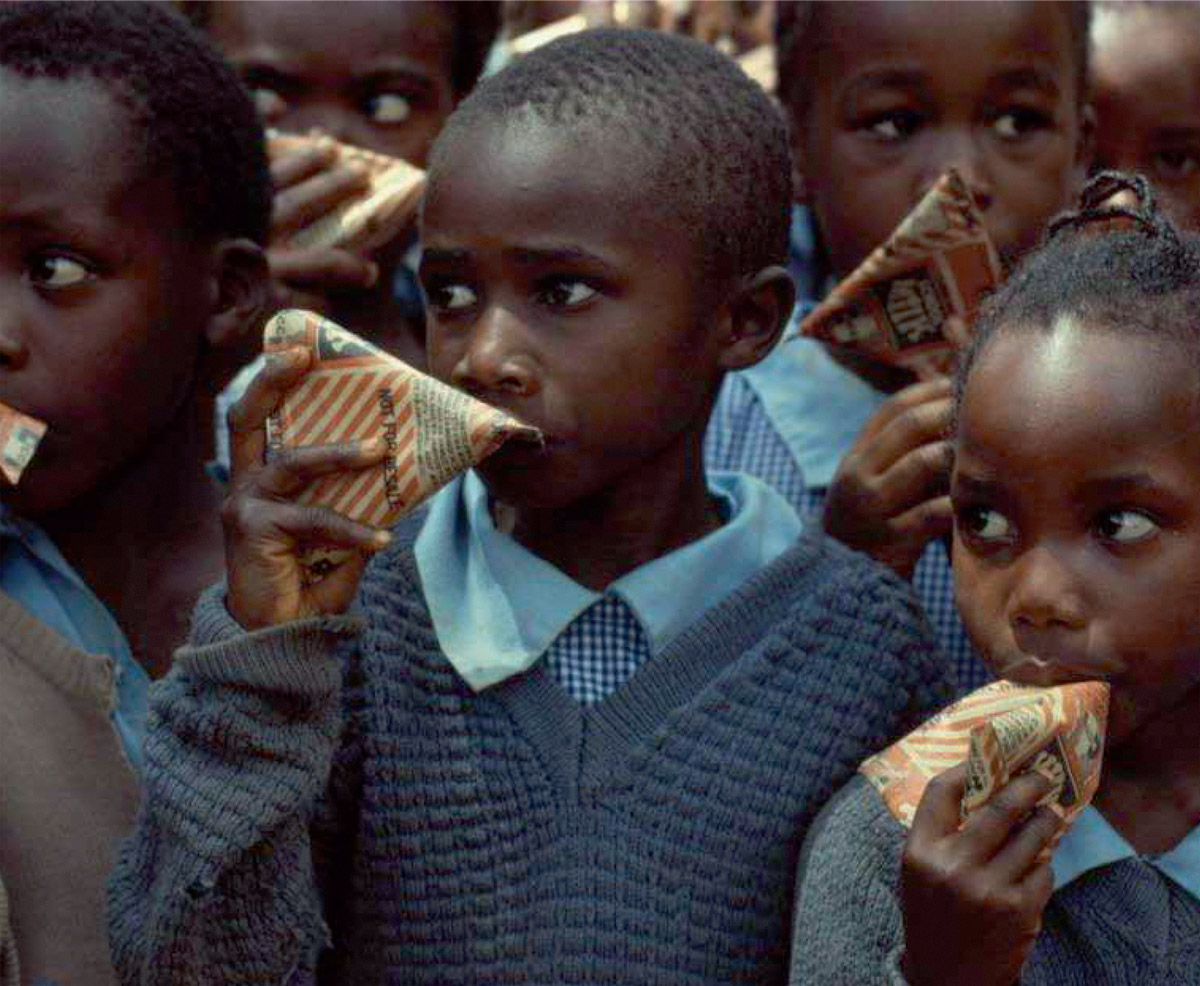
Current research aims to subsume the body of the cow entirely, as scientists attempt to generate “real” milk without the cow’s presence in the new field of “cellular agriculture.” Based on the promise of using milk cells as starter cells, but then regenerating milk synthetically, headlines ecstatically assert, “Animal lovers use biotech to develop milk made by man instead of a cow.”[12] The nexus of nature and technology offers a physical and imaginative emancipation of generative new materiality that defies bounded perceptions of body, gender, and species. What seems to be a turning point is also a continuity that can be perceived in the changing forms of milk over time. Milk is not just a life-giving liquid but also one latent with the power of annihilation, and its shapings are driven by the attempt to wrestle control of supply, as the mythic characters Hera and Opis knew.
Who is all this for? The ideal platonic form of the milk carton emerges in a subprime market for milk. Western markets are turning against cow’s milk as a degraded substance and are beginning to favor plant milk or milk without the cow, supertech milk from cows’ starter cells, the kind of milk men make in laboratories. Adult milk recapitulates the journey that formula milk made a hundred years before it. Billions of one-use plastic vessels leech toxins into land and water. The platonic forms and messages of health are now pitched elsewhere, “Deeper in the Pyramid.”
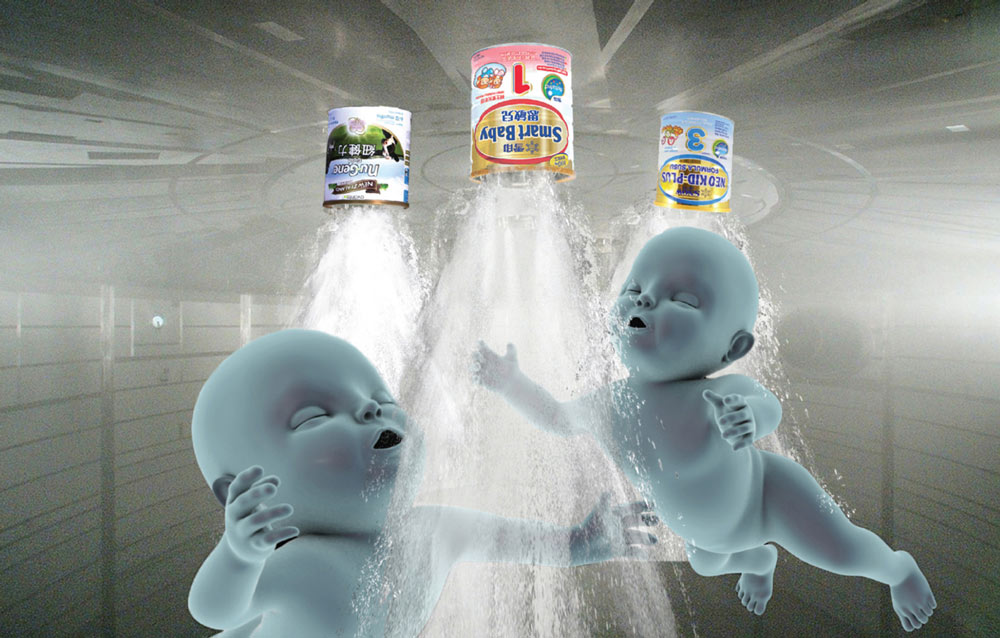
Since the 1950s, Tetra Pak’s Brancusi-like pyramid cartons have morphed from solid form into conceptual strategy and economic principle. Milk became an ur-form, a prototype that has been rolled out into multiple commodity lines. Tetra Pak currently sells five hundred million packages a day. Its latest corporate strategy is labeled “Deeper in the Pyramid.” A minimalist modernity is conceptualized as an economic principle that inserts its white arrows into the “economic pyramid” for a maximized return based on a presence radically more pervasive than is possible when the goal is to cream off revenues from an exclusive market. The strategy is focused on creating new markets among the population positioned toward the base of the economic pyramid. Currently, profits are gleaned from the pyramid’s apex on a high return from a relatively small number of sales. By digging deeper into the pyramid, by pitching specially adapted product lines made from lower-cost ingredients for the mass population living on subsistence income between EUR 1.80 and 7.20 a day, the exponential increase in low-return profits promises a “‘golden opportunity’ for international companies.”[13]
Milk is messy and compromised. Milk is original and pure. Milk is troubled, a turbid substance whose representation is difficult. It is presented as natural, health-giving, but is enmeshed in industrial processes and commercial strategies. It appears whole and entangled in life and liveliness, yet it speaks of death. To perceive the shapes within milk, the ways in which it has been shaped over time, is to give oneself up to its minglings, its combinations and recombinations with myth, social norms, social fantasy, and cultural practices. It means to conceive its expressibility, its capacity to be images, to seep into language and be made metaphorical. It necessitates thinking about the ways in which an orientation toward separation—from the body, from suppliers—has fed into its becoming abstracted for capital, into data, into something limitlessly reproducible and separate from or other to itself, as it flows between purity and abjection, the technoscientific and the bucolic, never settling, always spilling somewhere else.
- Luce Irigaray, “Women-Mothers, the Silent Substratum of the Social Order,” in The Irigaray Reader, ed. Margaret Whitford (Oxford: Blackwell, 1991), p. 47.
- Elizabeth Grosz, Volatile Bodies: Toward a Corporeal Feminism (Bloomington: Indiana University Press, 1994), p. 203.
- See Kenneth Hayes, Milk and Melancholy (Cambridge, MA: The MIT Press, 2008).
- Roozbeh Ghaffari, Ozge Nadia Gozum, Katherine Koch, Amy W. Ng, Hua Fung Teh, and Peter Yang, “Harold Edgerton in World War II” (unpublished manuscript, 15 December 2000). Available at web.mit.edu/6.933/www/Fall2000/edgerton/EdgertonWW2.pdf.
- See daviddavidgallery.com/artists/willem-de-kooning2.
- Calder M. Pickett, Voices of the Past: Key Documents in the History of American Journalism (Columbus, OH: Grid, 1977), p. 344.
- This popular truism about training in CGI can be found circulating on various blogs and forums. See, for example, helloyoucreatives.com/post/3307413119/cgi-milk-we-think-its-the-first-thing-everyone.
- See Meredith Martin, “Dairy Cases,” Cabinet, no. 40 (Winter 2010–2011). See also her Dairy Queens: The Politics of Pastoral Architecture from Catherine de’ Medici to Marie-Antoinette (Cambridge, MA: Harvard University Press, 2011).
- Proceedings of the World’s Dairy Congress, vol. 1 (Washington, DC: Government Printing Office, 1924), p. 15.
- Jack Smith, IV, “Milk Is the New, Creamy Symbol of White Racial Purity in Donald Trump’s America,” Mic, 10 February 2017. Available at mic.com/articles/168188/milk-nazis-white-supremacists-creamy-pseudo-science-trump-shia-labeouf#.PdAI0a51.
- Alexis C. Madrigal, “The Perfect Milk Machine: How Big Data Transformed the Dairy Industry,” The Atlantic, 1 May 2012. Available at theatlantic.com/technology/archive/2012/05/the-perfect-milk-machine-how-big-data-transformed-the-dairy-industry/256423.
- Tuan C. Nguyen, “Animal Lovers Use Biotech to Develop Milk Made by Man Instead of a Cow,” The Washington Post (Washington, DC), 21 July 2014. Available at wpo.st/kW6d2.
- See Tetra Pak Magazine, no. 104 (2015), dedicated to the theme “Deeper in the Pyramid,” p. 3. Available at endpoint895270.azureedge.net/static/documents/tp-magazine-no-104.pdf.
Melanie Jackson is an artist working with writing, moving image, and sculpture. She is based in London and represented by Matt’s Gallery. Recent solo exhibitions in London include “The Urpflanze (Part 1)” and “The Urpflanze (Part 2)” at Drawing Room and Flat Time House, respectively. This article is part of a collaboration with Esther Leslie, and is an extract from their forthcoming book Deeper in the Pyramid, which will be launched at their exhibition of the same name at Grand Union, Birmingham, in spring 2018.
Esther Leslie is professor of political aesthetics at Birkbeck, University of London. Her books include Hollywood Flatlands: Animation, Critical Theory and the Avant-Garde (Verso, 2002); Synthetic Worlds: Nature, Art and the Chemical Industry (Reaktion Books, 2005); Derelicts: Thought Worms from the Wreckage (Unkant, 2014); and Liquid Crystals: The Science and Art of a Fluid Form (Reaktion Books, 2016).
Spotted an error? Email us at corrections at cabinetmagazine dot org.
If you’ve enjoyed the free articles that we offer on our site, please consider subscribing to our nonprofit magazine. You get twelve online issues and unlimited access to all our archives.